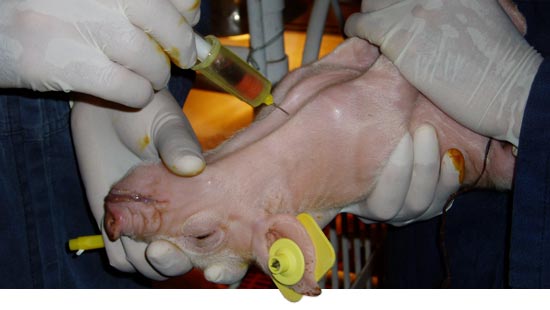In a recent publication in the Journal of the American Veterinary Medical Association, the cost of PRRS was estimated to be 560 million US dollars each year. In this article, several interesting points were made. First of all, it was noted that these were only the direct costs of the disease, i.e., costs secondary to production losses. In other words, this estimate did not include the extra costs incurred due to vaccination, diagnostic testing, treatment protocols for opportunistic pathogens secondary to PRRS virus infection, etc. Therefore, the estimate of 560 million per year is conservative. Another interesting point raised by the authors was the majority (88% or approximately 496 million of the losses occurred in the growing pig population, in contrast to only 67 million in the breeding herd. Finally, when adjusted on the basis of the value of the US dollar in the year 2004 when the study was conducted, the cost of PRRS far exceeded the estimated costs of classical swine fever and pseudorabies (364 million and 36 million respectively,) in the US.
The fact that these two diseases have been eradicated from the US has led to a great deal of discussion regarding the feasibility of eradication of PRRS from the North American pig population. In 2005, the American Association of Swine Veterinarians (AASV) published a position statement of PRRS eradication, which read as follows:
“Porcine reproductive and respiratory syndrome (PRRS) is a significant production-limiting disease of swine that is estimated to cost the US industry approximately 560 million dollars per year. Control of the disease via traditional methods has not been effective in all cases; therefore, it is the position of the AASV that eradication of the disease from the North American swine industry is the long term goal. The AASV will take a leadership role by partnering with the swine industry to promote collaborative PRRS eradication efforts at the local, regional, and national levels, communicating the need and identifying sources of funding to support such initiatives, and assisting in the transfer of new PRRS-related information and technology across its membership, in order to achieve this goal.”
Following the publication of the statement, PRRS eradication based working groups have been formed throughout North American in an effort to assess the feasibility of elimination the virus and eradicating the disease from a region, or a group of farms. The first group to organize such a collaborative effort was located in Ontario, Canada and is known as the Ontario Swine Health Advisory Board or OSHAB. The members of OSHAB include the Ontario Association of Swine Veterinarians, the Ontario Pork Industry Council, along with the various sectors of the Ontario swine industry. This group is working closely with the Ontario Veterinary College at the University of Guelph and has raised a significant amount of funding that will be dedicated to PRRS research.

The use of diagnostics will allow producers and practitioners to work together towards the common goal of PRRS eradication.
Following the lead of OSHAB, various state-based groups, i.e. Minnesota and North Carolina have been developed to begin the discussion on how to develop long-term control and eradication plans for their respective states. In addition, the AASV PRRS committee has been organized in order to provide direction, knowledge, resources and coordination for national and regional PRRS virus elimination efforts. This group will also facilitate the dissemination of information regarding the progress of these efforts as well as any other information pertinent to achieving the AASV's long-term goal of eradicating the disease from the North American swine herd. It is hoped that such efforts will enhance communication and collaboration across groups and stimulate the initiation of regional PRRS eradication pilot projects in order to demonstrate that sustainable eradication is possible within a group of farms.
Besides the challenges of organizing the infrastructure for this type of effort, another major obstacle to the initiation of regional projects is the issue of sustainable eradication. While it has clearly been demonstrated that PRRS virus can be eliminated from farms through a number of well-described methods, preventing the re-introduction of new strains of the virus is difficult. Therefore, a great deal of research has gone into identifying the routes of PRRS virus transmission as well as the validation of biosecurity protocols to prevent spread. While much progress has been made in the areas of transport biosecurity, insect control programs, and the understanding the role of personnel and fomites in the spread of the virus, re-infection still occurs. Recent breakthroughs in the role of isolate pathogenicity on the aerosol transmission of PRRS virus have re-initiated a great deal of research in the areas of PRRS virus aerobiology at Iowa State University and aerosol biosecurity at the University of Minnesota. These 2 groups are collaborating in an effort to understand risk factors that are important for aerosol spread as well as develop and test cost-effective air filtration methods for reducing the risk of this route of transmission. It is hoped that once this information is available, producers and practitioners can work together to implement PRRS eradication and biosecurity plans across regions of farms and take a major step forward towards achieving the long-term goal of PRRS eradication from the North American pig population.




